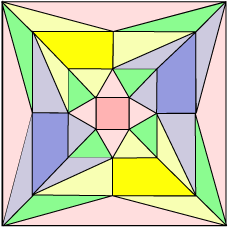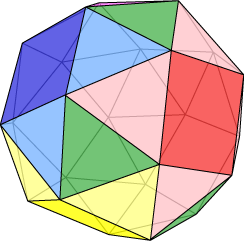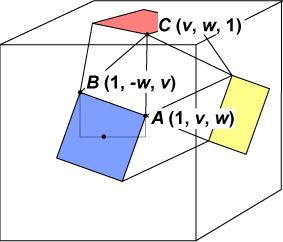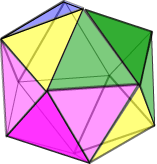|
The snub cube can be constructed in the following way. Starting with a cube, the faces are pulled outwards, all given a small clockwise turn, and adjusted in their placing so that the remaining surface is filled exactly with equilateral triangles. The solid has a definite orientation. A snub cube of reverse orientation can be constructed as above, by giving all the cube faces an anti-clockwise turn. The solid can be nicely coloured to illustrate this construction. Here the dark red, yellow and blue squares are derived from the original cube. Each square face is surrounded by its won ring of four equilateral triangles, and green equilateral triangles are placed at regular intervals to fill in the remaining gaps. The snub cube can also de derived from the octahedron, and is sometimes called a snub octahedron or a snub cuboctahedron, combining the two properties. We look more closely at this shortly.
The defect angle is 360° – 90° – (4 x 60)° = 30°. From our previous work, V = 720 / 30 = 24. Or as usual, we can compute the number of edges by This Schlegel diagram is interesting in that it demonstrates that the solid has an orientation. You might like to count the triangles and the ‘squares’, and check out the way that they are arranged. MathWorld gives some details about various measurements associated with this solid.
As before, we can use this Java applet to play with each of the Archimedean solids. Take time to enjoy the different views. Look for special symmetries and nice arrangements of faces and edges.
The making of the model of the snub cube is an interesting challenge, but not difficult. See this link for some details.
(In the construction of the snub cube) ... the dark red, yellow and blue squares are derived from the original cube. Each square face is surrounded by its won ring of four equilateral triangles, and green equilateral triangles are placed at regular intervals to fill in the remaining gaps. This suggests that there might be other polyhedra which can be constructed in this way.
You might expect there to be a further member of the snub family. Why? We shall come to it later!
Let us take the original cube to have vertices
We obtain Subtracting, we get v2 (1 – w2 ) = w(1 – w2 ), and since w2 < 1 we deduce that v2 = w. Furthermore, vw + v + w – 1 = 0 and l2 = 2(v2 + w2 ) give v3 + v2 + v – 1 = 0 , and l2 = 2(v4 + v2 ) .
We see that the vertex coordinates of A are (1, v, v2), where v is the real solution of v3 + v2 + v = 1. This is found, numerically or otherwise, to be approximately 0.54369. Using the rather constrained symmetry of the snub cube, the vertex coordinates are found to be: all even permutations of ( and all odd permutations of ( There are 12 of each of these, (three permutations, and four sign arrangements) giving a total of 24 coordinate sets, as expected. In the first case, remember the sign combination – – – .
Construction : Wenninger, M. J., Polyhedron models, Cambridge (1971). Vertex coordinates:
|
 SNUB CUBE
SNUB CUBE


